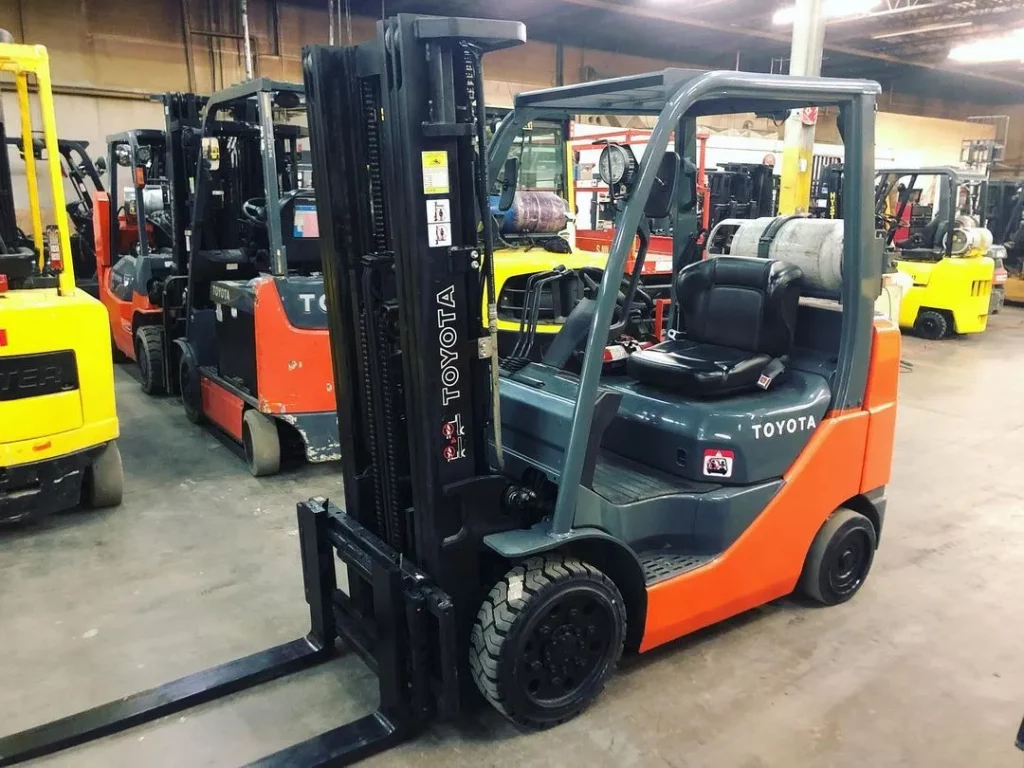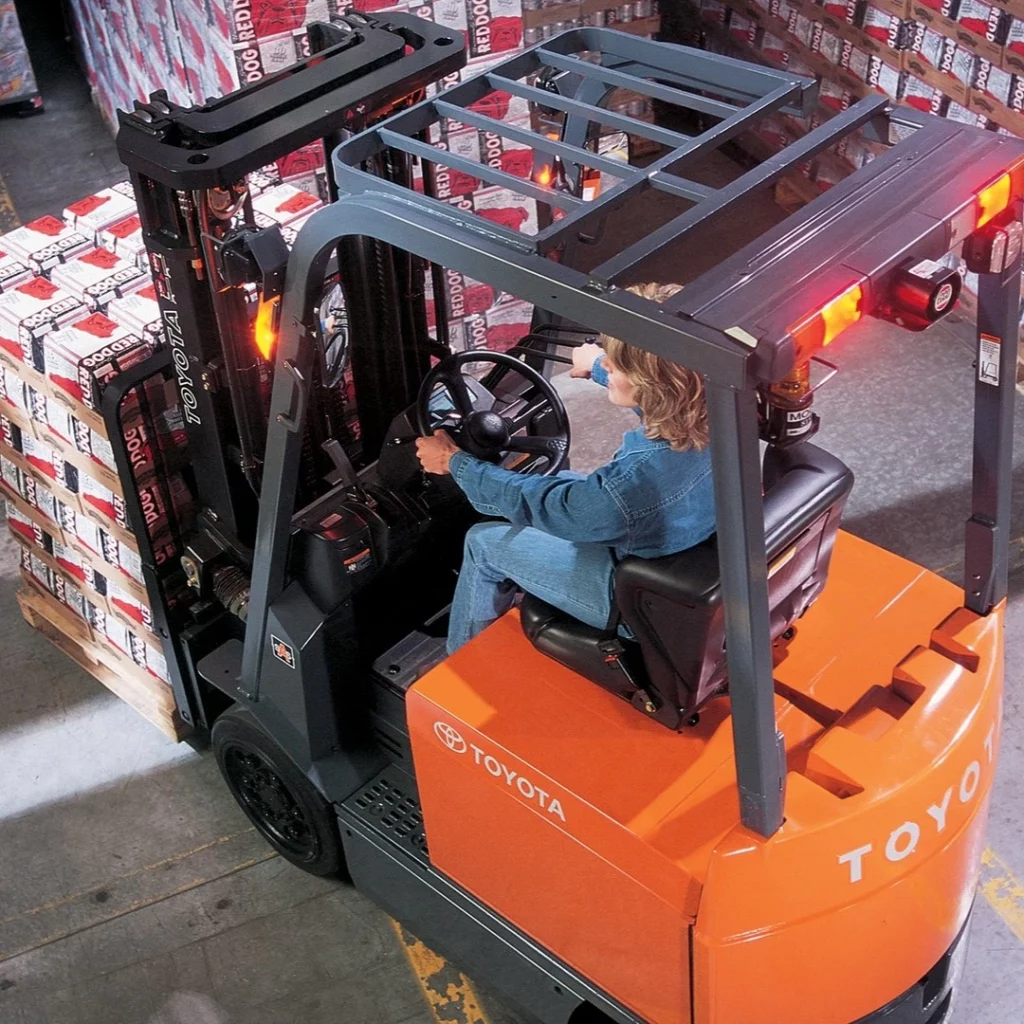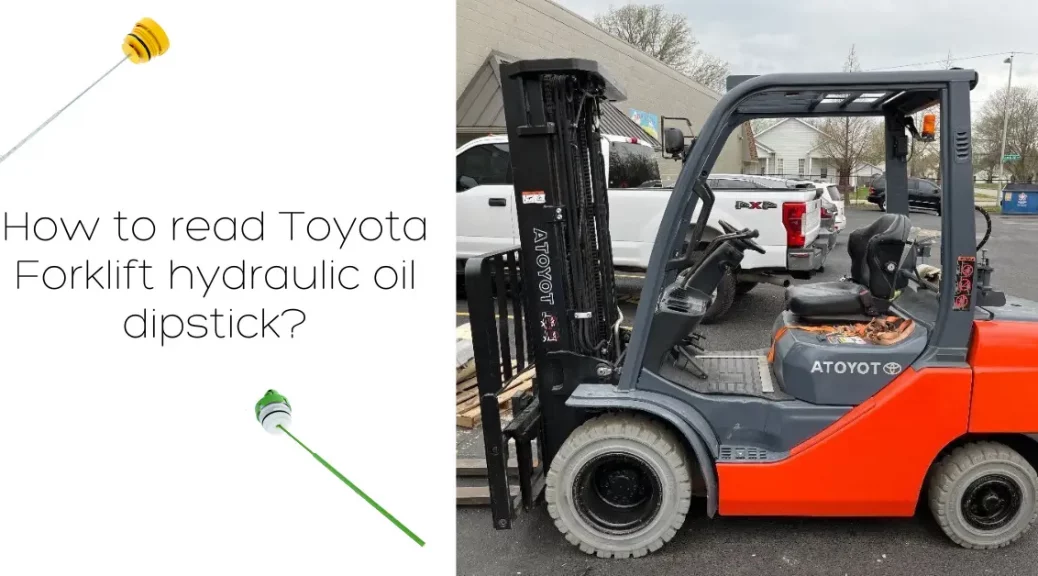Learning how to read Toyota Forklift hydraulic oil dipstick is an important skill for forklift operators. So as to ensure proper maintenance and performance of the machine. Understanding the readings on the forklift’s dipstick can help identify potential issues with the hydraulic system, such as low fluid levels or a hydraulic leak.
How To Read Toyota Forklift Hydraulic Oil Dipstick?
1). Park the forklift on level ground. The operator should park the forklift on a level surface to ensure the even distribution of hydraulic oil in the tank.
2). Lower the forks and the lift cylinders to the ground. Ensure that the forks and the lift cylinders are lowered to the ground and in a level position. When the forks and lift cylinders are elevated or tilted, it will cause some of the hydraulic fluid to be in the lift cylinders. And you won’t get an accurate reading.
3). Set the parking brake. To prevent the forklift from moving, set the parking brake.
4). Turn off the engine. Switch off the engine and wait for 5 to 10 minutes to allow all the hydraulic fluid to be pushed back into the reservoir. This will ensure that you get an accurate reading.
5). Remove the cap from the forklift hydraulic fluid reservoir. If you’re unsure of the dipstick’s location, refer to the owner’s manual to locate the hydraulic tank. Most Toyota Forklift models have the hydraulic fluid reservoir located near the battery.
6). Pull out the dipstick and wipe it clean. Pull out the dipstick, wipe it clean with a clean rag, and ensure it’s dry before reinserting it.
7). Reinsert the dipstick and remove it again to check the oil level. Insert the dipstick fully and remove it again to check the oil level. The dipstick has markings on it (usually notched, dimpled, scribed, or numbered) indicating the acceptable range for the hydraulic oil level.
8). Check the oil level. The optimal hydraulic fluid level is between the ‘Medium’ to ‘High’ marks. If the oil level is above the ‘high’ mark, it may result in leakage or spills when the engine is hot and running. If the oil level is below the ‘low’ mark, it may impact the forklift’s lifting and steering abilities.

Types Of Dipsticks Found In Toyota Forklifts
Toyota Forklift models use several types of dipsticks. Some common types of dipsticks include:
Flexible dipstick: This type of dipstick is made of a flexible material, such as plastic or rubber, and is commonly used in newer models. It may have numbered markings on it to indicate the oil level.

Steel rod dipstick: This type of dipstick is made of a steel rod and is commonly used in older models. It may also have numbered or dotted markings on it to indicate the oil level.

Electronic dipstick: This type of dipstick is used in modern variants and does not require manual checking. It uses sensors to measure the oil level and displays it on the vehicle’s dashboard.
Regardless of the type of dipstick used, the most important thing to focus on is the high and low marks on the dipstick. These marks indicate the minimum and maximum levels of the fluid. And should be used as a guide to ensure that the fluid is at the appropriate level.
In the case of the Toyota Forklift, the hydraulic fluid level should be at or near the high mark to ensure the proper functioning of the hydraulic system. The hydraulic system includes components such as the hydraulic pump, cylinders, and hoses, which are responsible for lifting and moving loads. Maintaining the proper hydraulic fluid level is essential for the safe and efficient operation of the forklift.
Locating The Hydraulic Oil Dipstick On Your Toyota Forklift
The location of the hydraulic oil dipstick on a Toyota forklift varies depending on the forklift model. However, there are some common areas to look for the dipstick, which include:
- Behind the operator’s seat
- On the side of the forklift mast
- On the hydraulic fluid reservoir
If you’re having trouble locating the hydraulic oil dipstick, you can refer to your forklift’s user manual for guidance. The manual will provide detailed instructions on where to find the dipstick and how to read it.
Tips For Finding The Dipstick In Hard-to-Reach Areas
Some forklift models have hydraulic oil dipsticks in hard-to-reach areas, making it challenging to check the hydraulic oil level. If you’re having trouble finding the dipstick, here are some tips that can help:
- Use a flashlight to spot the dipstick. This can help you locate the dipstick in dimly lit areas or areas with poor visibility.
- If the dipstick is still challenging to find, you can use a mirror to see the reflection. This can help you locate the dipstick even if it’s in a tight or hard-to-reach area.
- If you’re still having trouble finding the dipstick, seek help from a forklift technician. A technician will have the necessary tools and expertise to locate the dipstick quickly and efficiently.
Understanding The Importance of Hydraulic Oil In A Toyota Forklift
The hydraulic oil in a forklift serves multiple functions, including lubricating moving parts, transferring power, and reducing heat buildup. Without it, the forklift wouldn’t be able to perform its primary functions, which include lifting and transporting heavy loads. Therefore, it’s essential to keep the hydraulic oil at the optimal level and quality.
Functions Of Hydraulic Oil In A Forklift
The hydraulic oil in a forklift is a critical component that performs several essential functions.
One of the primary functions of hydraulic oil is to lubricate the moving parts of the forklift. This lubrication helps to reduce friction between the parts, which can cause wear and tear over time.
Additionally, hydraulic oil helps to transfer energy from one area to another, which is crucial for the forklift’s operation.
The hydraulic oil also helps to cool the system parts, preventing overheating, and reducing the risk of breakdowns.
Finally, hydraulic oil helps to prevent rusting of metal parts, which can occur due to exposure to moisture.
It is important to note that the hydraulic oil’s quality and level play a critical role in the forklift’s performance. If the hydraulic oil level is low or the oil is contaminated, it can cause significant problems that can lead to breakdowns and increased maintenance costs.

Signs Of Low Or Contaminated Hydraulic Oil
It’s essential to pay attention to the signs that indicate low or contaminated hydraulic oil in a forklift. Here are some of the most common signs:
- Difficulty in lifting or lowering loads: If you notice that the forklift is struggling to lift or lower loads, it could be a sign of low or contaminated hydraulic oil. This issue can cause the forklift to work harder, leading to premature wear and tear on the parts.
- Unusual noises from the hydraulic system: Unusual noises, such as grinding or whining, can be a sign of low or contaminated hydraulic oil. If left unaddressed, this issue can cause damage to the hydraulic system.
- Unusual increase in temperature: If you notice that the forklift’s temperature is rising unusually, it could be a sign of low or contaminated hydraulic oil. Overheating can cause significant damage to the forklift’s engine and other parts.
- Slow movement of the hydraulic cylinder: If the hydraulic cylinder is moving slowly, it could be a sign of low or contaminated hydraulic oil. This issue can cause the forklift to work harder, leading to premature wear and tear on the parts.
- Irregular pressure through the hydraulic system: If you notice that the pressure through the hydraulic system is irregular, it could be a sign of low or contaminated hydraulic oil. This issue can cause the forklift to work harder, leading to premature wear and tear on the parts.
It’s important to address these signs as soon as possible to prevent further damage to the forklift. Regular maintenance and inspection of the hydraulic oil can help prevent these issues from occurring.
Recommended Hydraulic Oil Change Intervals
Toyota, a major forklift manufacturer, recommends that the hydraulic oil be replaced every 6 months or after 1,000 hours of use to ensure the hydraulic system’s proper functioning. This regular maintenance can help to prevent costly breakdowns and ensure that the forklift remains safe to operate. It is the responsibility of the forklift operator to check the hydraulic fluid level during the pre-shift inspection and ensure that it is at the appropriate level.
FAQs
How To Prepare A Forklift For An Accurate Hydraulic Oil Reading?
To prepare a forklift for an accurate reading of the hydraulic oil dipstick:
- First, park the forklift on level ground.
- Lower the forks and the lift cylinders to the ground and ensure they are in a level position, as elevated or tilted forks and cylinders can result in inaccurate readings.
- Turn off the forklift engine and allow the hydraulic system to cool down for approximately ten minutes. This allows the hydraulic oil to settle at the correct level and temperature for an accurate reading. Avoid checking the dipstick immediately after turning off the engine, as the oil level may appear higher due to oil still circulating in the system.
What To Do If Your Hydraulic Oil Level Is Too Low?
If your hydraulic oil level is too low, you need to top it up slowly until it reaches the ‘Full’ mark. It’s important to use the correct type of hydraulic oil recommended by the forklift manufacturer to avoid damaging the hydraulic system. Before adding the hydraulic oil, ensure that the forklift is on level ground and the engine is turned off. Once the hydraulic oil level is optimal, start the forklift and let it operate for a few minutes to ensure it’s working correctly.
It’s also essential to check for any leaks that may have caused the hydraulic oil level to drop. Leaks can occur due to damaged hoses, seals, or fittings. If you notice any leaks, it’s crucial to have them repaired promptly to avoid further damage to the hydraulic system.
What to Do If Your Hydraulic Oil Level Is Too High?
If your hydraulic oil level is too high, you need to drain out some of the oil until it reaches the optimal level. Overfilling the hydraulic oil system can cause leaks and damage the hydraulic system’s components. It’s important to use a clean container to collect the excess hydraulic oil and dispose of it properly.
Overfilling can also cause foaming, which can lead to air entering the hydraulic system. Air in the hydraulic system can cause cavitation, which can damage the hydraulic pump and other components. If you notice any foaming, it’s essential to drain out the excess hydraulic oil and refill it to the optimal level.

Excellent post. I will be going through some of these issues as well..